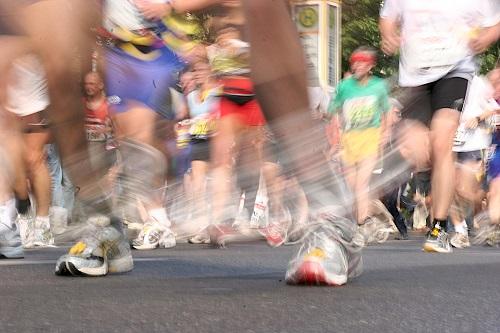

The organization recently issued guidelines developed to help reduce the likelihood of COVID-19 transmission among event participants, volunteers, staff members and communities at large. With the formal title of “Return to Racing: Guidance on SARS-CoV-2 transmission risk mitigation during running events,” the 15-page document was written by Dr. Brooke Nichols, an assistant professor in the Department of Global Health at Boston University’s School of Public Health, as well as a health economist and infectious disease mathematical modeler.
“Given the relatively limited risk of SARS-CoV-2 transmission outdoors, coupled with several mitigation measures, it is possible to continue racing while minimizing transmission risk,” Nichols wrote. “This paper is intended to provide interim guidance on safely operating running events in the time period between the beginning of vaccine rollout in the United States and prior to full epidemic control. As vaccination rates increase across the country, eventually the likelihood of severe diseases and mortality will decline, as will the likelihood of transmission events. However, during this transition period between a pandemic phase and endemic phase of the epidemic, many mitigation requirements are still required to keep participants, staff and volunteers safe in the context of running races.”
For example, she notes that the risk of transmission at outdoor gatherings is dependent on the amount of time spent in close contact with others, the number of people at the gathering, their ability to socially distance, and the use of face masks.
“In the context of racing, therefore, adequate mitigation measures at contact points, including registration/packet pick-up, the expo, baggage and gear check facilities, start and finish lines, water points and restrooms, are the most important in reducing the likelihood of a transmission event,” Nichols wrote.
The document also includes science-based tips for races of all sizes, broad mitigation measures, specific considerations for each contact point and special considerations for large events. Additionally, it urges race organizers to communicate with local public health departments and follow local protocols.
In late April, the Centers for Disease Control and Prevention issued new recommendations for fully vaccinated individuals, including participating in outdoor activities and recreation without a mask — except in crowded settings and venues. You are considered fully vaccinated two weeks after receiving the second dose of either the Pfizer-BioNTech or Moderna vaccines or two weeks after receiving the single-dose Johnson & Johnson vaccine.
“If you find yourself on a crowded route, you should protect yourself and those around you by wearing a mask, spreading out to maintain a distance of at least six feet from other runners … and avoiding unnecessary touching,” RunnersWorld.com suggests.
Running USA’s guidelines cite several running events that safely took place over the past several months — some with more than 5,000 participants — without any documented cases of COVID-19 transmission. They included Spartan Jacksonville (Florida) in February, Spartan San Antonio (Texas) in March and Tough Mudder Atlanta in April.
“Additionally, a recent race with nearly 5,000 participants in Japan resulted in zero reported cases in the two weeks post-race, suggesting no transmission events occurred during the event,” Nichols wrote. “Through these early events and the understanding of the science behind the mitigation of transmission events, there is now a growing body of evidence on how to return to running events safely. Larger scale events (including but not limited to Grandma’s Marathon, Bix 7, Boston Marathon, Chicago Marathon, Los Angeles Marathon, New York City Marathon) are now being planned for the summer and autumn in the United States.”
Runners are ready. According to internal data from online race manager RunSignUp, the number of year-over-year race signup transactions recently returned to 2019 levels for the first time in a year — an indication that, as the company proclaims, “events are back.”
“There is, of course, still regional variability, and the largest events have mostly moved later in the year or decided to go virtual,” RunSignUp notes on its blog. “We expect more ups and downs. But as we did an informal survey of the country, we found Q1 live events in the vast majority of states, even in the dead of winter when events are scarce in the best of years.”
Sports Destination Management has posted the Running USA guidelines, which are available to all event organizers courtesy of sponsors the Bank of America Chicago Marathon, Chicago Event Management, P3R and Brooks Sports, according to Running USA CEO Dawna Stone.

